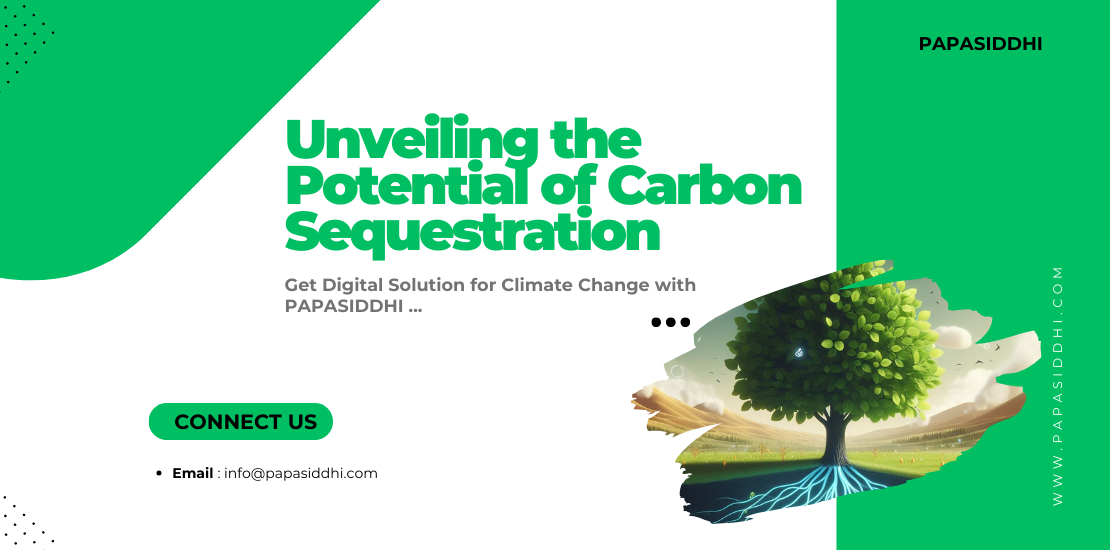- April 13, 2024
- Posted by: papasiddhi
- Category: Innovation

In the face of climate change, the need for innovative solutions to reduce carbon emissions has never been more urgent. While efforts to curb emissions at their source are essential, another powerful tool in our arsenal is often overlooked: carbon sequestration.
What is Carbon Sequestration?
Carbon sequestration is the process of capturing and storing carbon dioxide (CO2) from the atmosphere or preventing its release into the atmosphere. By removing CO2 from the air, we can mitigate its impact on the climate and help slow the pace of global warming.
Natural vs. Artificial Sequestration
There are two main types of carbon sequestration: natural and artificial.
Natural Sequestration: This occurs through natural processes such as photosynthesis, where plants absorb CO2 from the atmosphere and store carbon in their biomass and in the soil. Oceans also play a crucial role in natural carbon sequestration by absorbing CO2 from the atmosphere.
Artificial Sequestration: Artificial carbon sequestration involves human-engineered methods to capture and store CO2. This can include technologies like carbon capture and storage (CCS) systems, which capture CO2 emissions from industrial processes or power plants and store them underground in geological formations.
The Importance of Carbon Sequestration
Carbon sequestration offers several key benefits in the fight against climate change:
1. Climate Mitigation: By removing CO2 from the atmosphere, carbon sequestration helps reduce greenhouse gas concentrations and mitigates the impacts of climate change, such as rising temperatures, extreme weather events, and sea-level rise.
2. Enhanced Biodiversity: Natural carbon sequestration methods, such as reforestation and afforestation, can help restore ecosystems and support biodiversity. Healthy forests and ecosystems act as carbon sinks, absorbing CO2 and providing habitat for diverse plant and animal species.
3. Sustainable Development: Carbon sequestration technologies offer opportunities for sustainable development by enabling industries to reduce their carbon footprint while continuing to operate and innovate. This can help create new job opportunities and drive economic growth in the green economy.
4. Long-Term Solution: Carbon sequestration provides a long-term solution to carbon emissions by permanently storing CO2 underground or in natural sinks. This helps ensure that emissions reductions are not only achieved in the short term but also sustained over time.
Challenges and Opportunities
While carbon sequestration holds great promise, it also faces challenges, including technological barriers, cost considerations, and potential environmental risks associated with certain methods. However, ongoing research and development efforts are continuously improving carbon sequestration technologies and making them more efficient and cost-effective.
As we strive to transition to a low-carbon future, carbon sequestration will play a critical role alongside other mitigation measures. By harnessing the power of nature and innovation, we can unlock the full potential of carbon sequestration and pave the way to a greener, more sustainable world for future generations.
Papasiddhi’s Role in Environmental Conservation and Carbon Sequestration:
1. Innovative Solutions for Reforestation and Afforestation: Papasiddhi can provide and implement cutting-edge technology solutions to support reforestation and afforestation efforts. This may include designing mobile applications or web platforms to facilitate tree planting initiatives, engage volunteers, and track the growth and health of newly planted trees using data analytics and remote sensing technologies.
2. Carbon Footprint Monitoring and Management: Papasiddhi can provide custom software solutions for carbon footprint monitoring and management, allowing businesses and organizations to track their emissions, identify areas for improvement, and implement strategies to reduce their carbon footprint. This may involve developing carbon accounting tools, integrating IoT devices for real-time emissions monitoring, or implementing carbon offsetting programs.
3. GIS and Remote Sensing Applications: Papasiddhi’s expertise in geographic information systems (GIS) and remote sensing technologies can be invaluable for assessing land use changes, monitoring deforestation and forest degradation, and identifying suitable areas for reforestation and afforestation projects. By leveraging satellite imagery, LiDAR data, and other geospatial technologies, Papasiddhi can provide valuable insights for informed decision-making in environmental conservation efforts.
4. Community Engagement and Awareness: Papasiddhi can provide digital marketing campaigns, interactive websites, and mobile applications to raise awareness about the importance of environmental conservation and carbon sequestration. These tools can educate and empower individuals, communities, and organisations to take action, participate in tree planting initiatives, and support sustainable practices that contribute to carbon sequestration efforts.
5. Data Analytics and Machine Learning: Papasiddhi’s expertise in data analytics and machine learning can enhance carbon sequestration efforts by analysing large datasets related to climate, land use, and vegetation dynamics. By extracting actionable insights from data, Papasiddhi can optimize reforestation strategies, identify high-priority areas for conservation, and predict the long-term impact of environmental interventions on carbon sequestration.
Leave a Reply
You must be logged in to post a comment.
